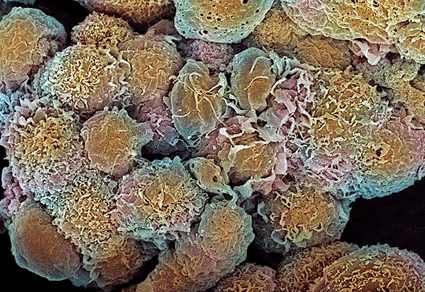Cell-to-Cell Contact Modulates MicroRNA Synthesis
By LabMedica International staff writers
Posted on 13 May 2009
Results of a recently published study suggest that cell biology researchers should consider the effect that cell-to-cell contact has on microRNA (miRNA) levels when evaluating the role of these gene regulators in cancer and other diseases.Posted on 13 May 2009
MicroRNAs are 18- to 24-nucleotide RNA molecules that regulate messenger RNAs (mRNAs). Posttranscriptional mechanisms regulate miRNA abundance during development as well as in cancer cells where miRNAs frequently exhibit abnormal expression.

Image: Colored scanning electron micrograph (SEM) of breast cancer cells (Photo courtesy of Steve Gschmeissner / SPL).
Investigators from Johns Hopkins University (Baltimore, MD, USA) chose to look at the effect of cell-to-cell contact on miRNA levels after observing that miRNAs were more abundant in the tissues of animals, where cells are packed together, than in isolated cells from the same tissues growing in culture. To this end they grew normal and cancerous cells to increasing densities in culture and measured the abundance of hundreds of microRNAs simultaneously. Results published in the April 9, 2009, online edition of the journal the Proceedings of the [U.S.] National Academy of Sciences (PNAS) revealed that the more densely the cells were packed together, the more microRNA was produced in each cell.
In a further study, the investigators examined microRNA production in five additional commonly studied human and mouse cell lines, including human breast cancer cells, human colorectal cancer cells, and human pancreatic cancer cells. They also tested fruit fly cells to determine whether or not the phenomenon was restricted to mammals. Results of this study confirmed that as diverse mammalian and fruit fly cell lines grew to increasing density, miRNA synthesis was globally activated, leading to elevated mature miRNA levels and stronger repression of target mRNAs.
"Little did we know the manufacture of microRNAs was so potently influenced simply by growing cells to different densities," said senior author Dr. Josh Mendell, assistant professor of genetic medicine at Johns Hopkins University. "We now recognize that this is a critical parameter that must be closely monitored when performing experiments with microRNAs in tissue culture. Through additional experiments, we were able to identify the specific molecular steps at which microRNA production is affected. We expect that this phenomenon will profoundly influence how cells behave in normal development and disease."
"If we can identify the mechanisms through which microRNA production is regulated in normal settings, such as under conditions of extensive cell-cell contact, we can then ask whether the same mechanisms block microRNA manufacture in diseases such as cancer," Dr. Mendell said. "This might allow the development of small molecules or other methods to turn microRNA production back on for therapeutic benefit."
Related Links:
Johns Hopkins University













